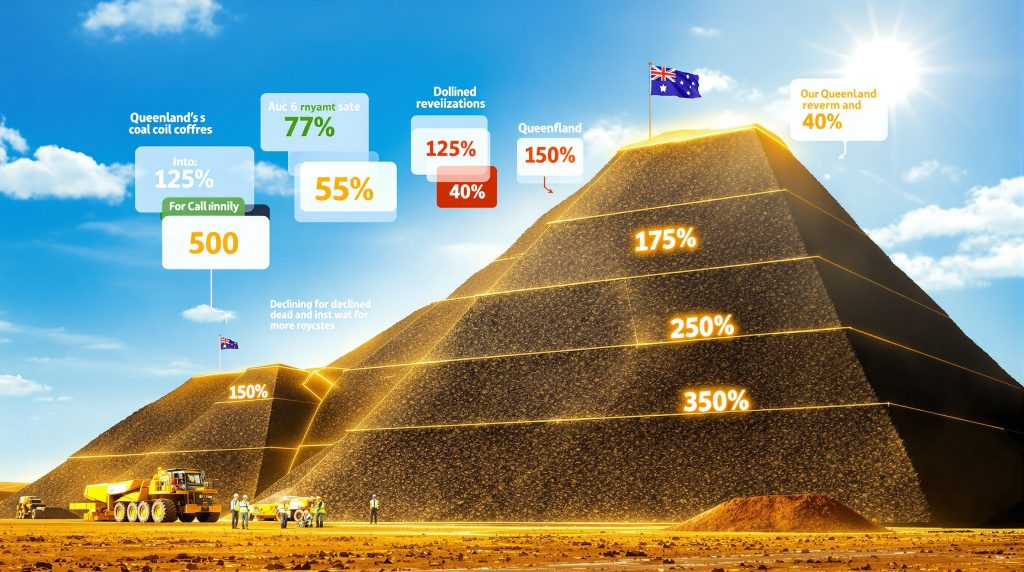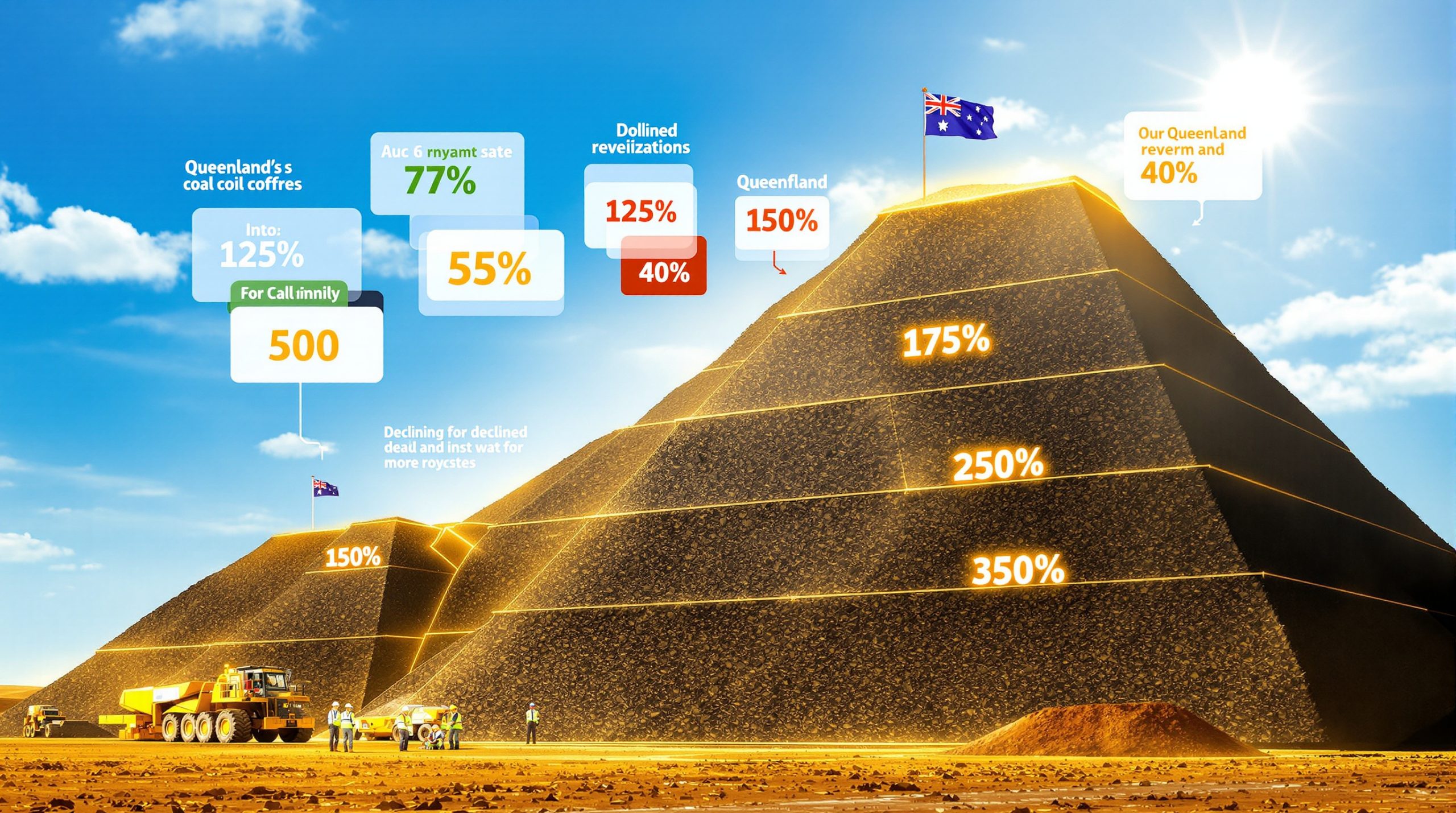Understanding Queensland's Coal Royalty Regime: Economic Impact and Industry Response
Queensland's coal royalty system has become a focal point of economic debate, with recent industry job cuts reigniting discussions about its impact on the state's crucial mining sector. The progressive tiered structure, unique in Australia's coal landscape, continues to generate both significant revenue for the state government and controversy within the industry.
How Does Queensland's Coal Royalty System Work?
Queensland employs a progressive tiered royalty structure that adjusts based on coal prices. This system functions somewhat like income tax brackets, with companies paying different rates on different portions of their coal's value. The structure allows the state to capture more revenue during boom periods while maintaining a lower burden when market conditions deteriorate.
The Tiered Structure Explained
The current framework includes multiple escalating tiers:
- 7% royalty rate when coal prices are below $100 per tonne
- 12.5% on the portion between $100-$150 per tonne
- 15% on the portion between $150-$175 per tonne
- 20% on the portion between $175-$225 per tonne
- 30% on the portion between $225-$300 per tonne
- 40% on any value above $300 per tonne
This progressive structure means mining companies pay significantly higher percentages during price spikes, with the top tier of 40% applying when coal prices exceed the $300 threshold. According to University of Queensland economics professor John Quiggin, this ensures that when coal prices rise dramatically, "the state gets a reasonable share rather than it all going towards company profits."
When and Why Were the Higher Tiers Introduced?
Timing of the 2022 Reforms
The Queensland government introduced three additional upper tiers (20%, 30%, and 40%) in the 2022-23 state budget. This represented the first major change to the royalty structure in a decade and coincided with record-high coal prices in global markets, allowing the state to capitalize on extraordinary resource profits.
Government Rationale for Higher Rates
The government justified the increased rates by emphasizing several key principles:
- The need for Queenslanders to receive a "fair share" of resource profits
- The opportunity to capture windfall gains during price spikes
- The principle that natural resources ultimately belong to all Queenslanders
- The desire to fund essential services and infrastructure
Then-Premier Annastacia Palaszczuk defended the changes firmly, stating during their introduction: "If the coal companies are making record prices, then they should return some of that share to Queenslanders."
Then-treasurer Cameron Dick further emphasized that the government sought a royalty response that was "fair and reasonable" to both coal companies and Queenslanders, noting that "at a time of very high profits and very high prices, Queenslanders deserve a share of that to go back precisely into the jobs and services they need."
What Financial Impact Has the Royalty Regime Had?
Revenue Generation for Queensland
The tiered royalty system has delivered substantial revenue to Queensland's budget:
| Financial Year | Coal Royalty Revenue | Notes |
|---|---|---|
| 2022-23 | $15.36 billion | Record high following royalty changes |
| 2023-24 | $10.52 billion | Decline as coal prices moderated |
| 2024-25 | $5.49 billion (est.) | Further reduction with market changes |
| 2025-26 | $6.17 billion (est.) | Slight projected increase |
This revenue stream has become crucial to Queensland's fiscal position, accounting for a significant portion of state income during peak collection years and creating what Central Queensland University professor John Rolfe describes as dependency issues: "It makes it hard for the government to adjust the numbers because the fiscal situation is tight, and if they do try and reduce royalties back to a more sensible position, it then puts other parts of the budget into trouble."
How Has the Mining Industry Responded?
Recent Job Cuts and Industry Reactions
The Queensland coal royalty regime has faced renewed scrutiny following a series of job cut announcements in September 2025:
- BHP Mitsubishi Alliance (BMA) announced approximately 750 job cuts and the mothballing of its Saraji South mine near Dysart
- Anglo American confirmed job losses across its Brisbane offices and Bowen Basin operations, reportedly affecting more than 200 positions
- QCOAL announced partial closure of its Cook Colliery mine near Blackwater
Industry representatives have explicitly cited the royalty structure as a contributing factor to these decisions. BMA asset president Adam Lancey described the government's coal royalties as "unsustainable," explaining that the tiered system meant the company was "losing the good times" by paying higher royalties during price spikes, which historically helped "sustain us through the tougher times."
Industry Arguments Against the Current System
The Queensland Resources Council (QRC) and mining companies have raised several concerns:
- The higher tiers reduce profitability during price spikes that historically helped companies weather downturns
- Queensland's system creates competitive disadvantages compared to other coal-producing regions
- The structure discourages long-term investment in Queensland coal projects
- The system creates uncertainty for operational planning and expansion decisions
QRC chief executive Janette Hewson has been vocal about the industry's position: "We have always been saying that royalties are going to hurt us as Queenslanders and now we are seeing the impacts of that."
How Does Queensland's System Compare to Other Jurisdictions?
Queensland vs. New South Wales
The contrast between Queensland's progressive system and the fixed-rate approach in New South Wales highlights different policy approaches:
| Jurisdiction | Royalty Structure | Rates | Industry Perception |
|---|---|---|---|
| Queensland | Progressive tiers | 7% to 40% depending on coal price | Criticized as unpredictable and potentially harmful to investment |
| New South Wales | Fixed rate | 8.8% to 10.8% | Viewed as providing greater certainty for operational planning |
MineLife senior resource analyst Gavin Wendt emphasized this competitive disadvantage: "The key factor here is we are not having issues with coal mines in NSW because the royalties system is completely different." He noted that while Queensland coal producers may be "losing money" per tonne, "that same tonne of coal in NSW you can be making money."
What Are the Political Dimensions of the Debate?
Current Government Position
The current Queensland government under Premier David Crisafulli has maintained the royalty structure despite industry pressure. During the 2024 election campaign, Crisafulli committed to keeping the system in place, and has recently reinforced this position when questioned about potential changes, advising the industry not to "hold out hope" for adjustments beyond 2028.
Opposition and Alternative Views
The debate has political dimensions beyond simple industry-government dynamics:
- Opposition Leader Steven Miles has argued that companies didn't close mines when the royalties were first introduced at higher coal prices, noting: "The coal price is now much lower than it has been over recent years and this didn't occur when those prices were higher, which is when those aggressive coal royalties would have kicked in more substantially"
- The government maintains it is "not at war with the mining sector" and is focusing on other ways to support the industry, with Deputy Premier Jarrod Bleijie stating they are "approving leases and mining approvals far more efficiently"
- National MP Colin Boyce has suggested the issue extends beyond royalties to include broader operational costs
What Other Factors Influence Mining Viability in Queensland?
Beyond Royalties: Multiple Pressures
Industry experts and politicians point to several factors beyond royalties affecting mining operations:
- Electricity costs for mining operations
- Transportation and shipping expenses
- Global market conditions and commodity price trends
- Regulatory compliance costs
- Labor market challenges
- Long-term energy transition trends
National MP for Flynn Colin Boyce, whose electorate encompasses key mining regions from Gladstone to Emerald, noted that mining companies face pressures from operational costs unrelated to royalties, including "the price of electricity, transport and shipping." This more holistic view suggests that attributing industry challenges solely to the royalty structure oversimplifies a complex operational environment.
Resource Industry Network general manager Dean Kirkwood added that recent job cuts couldn't simply be attributed to mining industry trends and cyclical nature, stating: "We've never had the cost pressures we have had now."
What Are the Long-Term Implications for Queensland's Coal Industry?
Future Outlook and Strategic Considerations
The debate around Queensland's coal royalties raises important questions about the future of the industry, which according to Central Queensland University professor John Rolfe generates up to 40,000 jobs across the state:
- How will the state balance revenue needs with industry sustainability?
- Can Queensland maintain its competitive position in global coal markets?
- What impact will the royalty structure have on future investment decisions?
- How might changing global demand for coal affect the calculus around royalty rates?
Colin Boyce expressed confidence in the sector's future despite current challenges: "I do believe the coal industry has a significant future, particularly here in Central Queensland. Coal is king and it will be for a very, very long time." The South African coal boost witnessed in similar global mining regions demonstrates that coal remains a vital energy resource despite transitions to renewables.
How Might the System Evolve?
Potential Paths Forward
Several possible approaches could address industry concerns while maintaining revenue for Queensland:
- Maintaining the status quo – Keeping the current system in place despite industry objections
- Modifying tier thresholds – Adjusting the price points at which higher rates apply
- Capping maximum rates – Reducing the top tier percentage to align more closely with other jurisdictions
- Creating certainty mechanisms – Establishing longer-term agreements about future royalty structures
- Developing targeted incentives – Offering royalty discounts for specific investments or operational improvements
Resource Industry Network general manager Dean Kirkwood suggested that providing longer-term certainty about royalty structures could help companies plan more effectively: "It might be simply a case of having an agreement on what royalties will look like in the next term. Then that gives a bit of surety, doesn't it, around what the future holds and therefore businesses can start to build around that."
What Questions Should Stakeholders Consider?
Key Considerations for the Future
The debate around Queensland's coal royalty regime raises several important questions:
- How can the state balance fair returns to citizens with industry competitiveness?
- What role should coal royalties play in Queensland's transition to a more diversified economy?
- How might changing global coal demand affect the calculus around royalty rates?
- What mechanisms could provide greater certainty while maintaining flexibility?
- How should environmental and social factors be incorporated into royalty considerations?
The ongoing resource export challenges faced by Australia's mining sector more broadly suggest that Queensland must carefully consider its approach to maintain global competitiveness.
FAQ: Queensland Coal Royalties
What is a coal royalty?
A coal royalty is a payment made by mining companies to the state government for the right to extract and sell coal resources, which are owned by the public. It represents the community's share of the value of these natural resources.
Why does Queensland use a tiered royalty system?
The tiered system allows the state to capture more revenue when coal prices are high while maintaining lower rates during market downturns, theoretically providing a balance between government revenue and industry viability.
How much revenue has Queensland generated from coal royalties?
Queensland collected a record $15.36 billion in coal royalties in 2022-23 following the introduction of higher tiers, with revenue declining to an estimated $5.49 billion in 2024-25 as coal prices moderated, according to Queensland Treasury's official budget papers.
What do mining companies want changed?
Mining companies and industry bodies have advocated for lower maximum rates, greater certainty about future royalty structures, and a system more comparable to other jurisdictions like New South Wales.
Will the Queensland government change the royalty structure?
Premier David Crisafulli has indicated that the government intends to maintain the current royalty structure, stating that the industry should not "hold out hope" for changes in the near term. However, he has hinted at an upcoming announcement of "an exciting new chapter for Queensland coal," suggesting potential policy developments beyond the royalty system itself.
The ongoing industry consolidation trends might influence how mining companies respond to the current royalty framework, with potential mergers or asset sales reshaping the Queensland coal landscape.
Disclaimer: This article analyzes current policies and industry positions regarding Queensland's coal royalty regime. The information provided is based on publicly available data and statements as of September 2025. Economic projections and policy positions may change as market conditions evolve. Readers should consult official Queensland royalty rate information for the most current information on royalty rates and policies.
Want to Identify the Next Major Mineral Discovery?
Discovery Alert's proprietary Discovery IQ model provides instant notifications when significant ASX mineral discoveries are announced, helping you position ahead of the market. Explore historic examples of exceptional investment returns on our dedicated discoveries page and start your 30-day free trial today.




